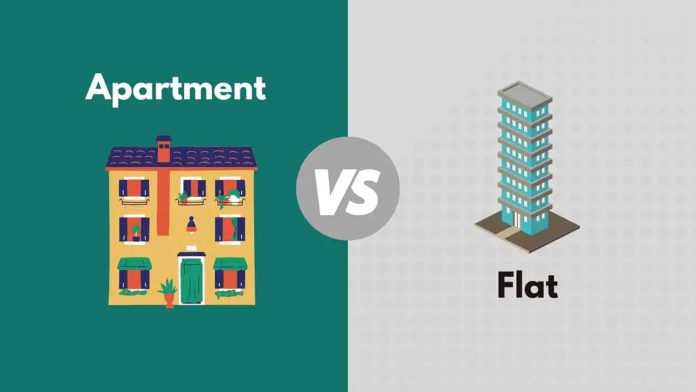Navigating the real estate environment can be difficult, particularly when deciding between a flat and an apartment. While these terms are frequently used interchangeably, knowing the distinction is critical, particularly in India. In the United States, “condo” or “apartment” is typical, although in the United Kingdom and Europe, “flat” is preferred. In India, real estate professionals believe there is no difference between a flat and an apartment. Both refer to dwellings having a group of rooms on the same level or in the same structure. This blog seeks to elucidate the finer points, allowing you to make sound investment selections depending on your budget, lifestyle, and preferences. Continue reading to learn about the differences between apartments and flats and decide which one is ideal for you.
1. What is a Flat?
Before we get into the discussion over flat vs flat, we should first understand where the terms came from. The term ‘flat’, for example, derives from the Old English ‘Flett’, which means a home, hall; floor, ground,’ or simply a floor or part of a level fitted up as a residence.
2. What is an Apartment?
The term flat is derived from the Italian word ‘Appartamento’, which means ‘private quarters for one person’s or a family’s usage in a house’ or location divided’. This is the US equivalent of the British term ‘flat’.
3. Difference Between a Flat and an Apartment?
| Aspect | Flat | Apartment |
| Terminology | Commonly used in the UK and some parts of Europe | Commonly used in the United States and other regions |
| Usage | Often used to describe a single-floor residence | Typically refers to multi-story residential units |
| Structure | Can be part of a larger building or standalone | Generally part of a larger complex or building |
| Ownership | Individual ownership may vary | Units are often individually owned or rented |
| Facilities | Limited common amenities within the unit | May include shared facilities like gym, pool, etc. |
| Lifestyle | May suit those seeking simplicity | Appeals to those desiring a more communal lifestyle |
| Regional Variations | Widely used term in India | Usage may vary based on local preferences and trends |
4. Pros And Cons of Apartment Vs Flat in India
| Aspect | Apartment | Flat |
| Terminology | Commonly used in the United States and other regions | Commonly used in the UK and some parts of Europe |
| Usage | Typically refers to multi-story residential units | Often used to describe a single-floor residence |
| Structure | Generally part of a larger complex or building | Can be part of a larger building or standalone |
| Ownership | Units are often individually owned or rented | Individual ownership may vary |
| Amenities | May include shared facilities like gym, pool, etc. | Limited common amenities within the unit |
| Lifestyle | Appeals to those desiring a more communal lifestyle | May suit those seeking simplicity |
| Security | Generally has better security measures | Security measures may vary |
| Maintenance | Shared maintenance responsibilities | Individual maintenance control |
| Resale Value | Generally better resale value due to added facilities | Resale value may vary based on location and demand |
| Investment Appeal | Attracts a broader range of tenants and buyers | Appeals to those seeking simplicity |
| Cost | Often comes with a higher price tag | May have a lower initial cost |
| Privacy | Limited privacy due to shared spaces | Offers more privacy within the unit |
| Customization | Limited ability to customize the space | More freedom to customize the flat |
| Space | Units may be smaller compared to flats | Potentially larger living spaces |
| Ownership Control | Shared ownership control in common areas | Full ownership control over the entire unit |
| Maintenance Decisions | Decisions may be collective and take time | Individual control over maintenance decisions |
5. Difference b/w Amenities You Want in Regardless of Flat Apartment
When deciding between an apartment and a flat, keep in mind that most people base their decision only on the number of bedrooms they require, the amount of space available, the basic facilities, the monthly rent, and the total deposit. As their study progresses, people look for locations that are close to their office, have simple access to public transport (such as the metro), and are pet friendly. As it progresses, more features may become deal-breakers. This means that, while the range of amenities may vary, you should include a few must-haves on your list. Even qualities you seem are unnecessary may wind up making your life easier, more fun, productive, and healthy.
6. Must-Have Amenities for Your New Home
Finding your dream home goes beyond the debate between flats and apartments. Here are some essential amenities to prioritize regardless of the building type:
- Security: A secure living environment is key. Look for a well-maintained building with a visitor management system that tracks entry and exit, including domestic staff and deliveries.
- Convenience: Modern amenities like elevators, parking spaces, and power backup contribute to a comfortable lifestyle. Ensure these are present and well-maintained.
- Accessibility: Easy access to public transportation is a huge plus. Consider your needs and prioritize a location close to necessary routes. If you own a vehicle, secure parking within the building complex is ideal.
- Effective Communication: A responsive building management committee is crucial. Look for a system where you can easily register complaints and get timely resolutions for maintenance issues.
By prioritizing these amenities, you can ensure your new home is not only secure and comfortable but also convenient for your daily life.










































